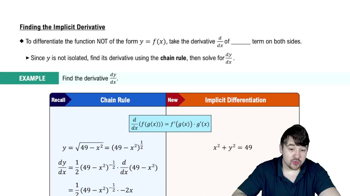Table of contents
- 0. Functions7h 52m
- Introduction to Functions16m
- Piecewise Functions10m
- Properties of Functions9m
- Common Functions1h 8m
- Transformations5m
- Combining Functions27m
- Exponent rules32m
- Exponential Functions28m
- Logarithmic Functions24m
- Properties of Logarithms34m
- Exponential & Logarithmic Equations35m
- Introduction to Trigonometric Functions38m
- Graphs of Trigonometric Functions44m
- Trigonometric Identities47m
- Inverse Trigonometric Functions48m
- 1. Limits and Continuity2h 2m
- 2. Intro to Derivatives1h 33m
- 3. Techniques of Differentiation3h 18m
- 4. Applications of Derivatives2h 38m
- 5. Graphical Applications of Derivatives6h 2m
- 6. Derivatives of Inverse, Exponential, & Logarithmic Functions2h 37m
- 7. Antiderivatives & Indefinite Integrals1h 26m
- 8. Definite Integrals4h 44m
- 9. Graphical Applications of Integrals2h 27m
- 10. Physics Applications of Integrals 2h 22m
4. Applications of Derivatives
Implicit Differentiation
Problem 70a
Textbook Question
The following equations implicitly define one or more functions.
a. Find dy/dx using implicit differentiation.
y² = x²(4 − x) / 4 + x (right strophoid)
 Verified step by step guidance
Verified step by step guidance1
Start by differentiating both sides of the equation with respect to x. Remember that y is a function of x, so when differentiating terms involving y, use the chain rule.
Differentiate the left side: The derivative of y² with respect to x is 2y(dy/dx) using the chain rule.
Differentiate the right side: Use the quotient rule for the term x²(4 − x) / 4. The quotient rule states that if you have a function u/v, its derivative is (v(du/dx) - u(dv/dx)) / v².
Apply the product rule to differentiate x²(4 − x). The product rule states that if you have a function u(x)v(x), its derivative is u'(x)v(x) + u(x)v'(x).
After differentiating both sides, solve for dy/dx by isolating it on one side of the equation. This will give you the expression for dy/dx in terms of x and y.
 Verified video answer for a similar problem:
Verified video answer for a similar problem:This video solution was recommended by our tutors as helpful for the problem above
Video duration:
7mPlay a video:
Was this helpful?
Key Concepts
Here are the essential concepts you must grasp in order to answer the question correctly.
Implicit Differentiation
Implicit differentiation is a technique used to find the derivative of a function that is not explicitly solved for one variable in terms of another. Instead of isolating y, we differentiate both sides of the equation with respect to x, applying the chain rule when necessary. This method is particularly useful for equations where y cannot be easily expressed as a function of x.
Recommended video:

Finding The Implicit Derivative
Chain Rule
The chain rule is a fundamental principle in calculus that allows us to differentiate composite functions. It states that if a function y is defined as a function of u, which in turn is a function of x, then the derivative of y with respect to x is the product of the derivative of y with respect to u and the derivative of u with respect to x. This is essential in implicit differentiation when differentiating terms involving y.
Recommended video:

Intro to the Chain Rule
Right Strophoid
The right strophoid is a specific type of curve defined by a particular mathematical equation. In the context of the given problem, it is represented by the equation y² = x²(4 − x) / 4 + x. Understanding the properties and shape of the right strophoid can provide insights into the behavior of the function and its derivatives, which is crucial for solving the implicit differentiation problem.
Recommended video:

Left, Right, & Midpoint Riemann Sums

 5:14m
5:14mWatch next
Master Finding The Implicit Derivative with a bite sized video explanation from Nick
Start learningRelated Videos
Related Practice


